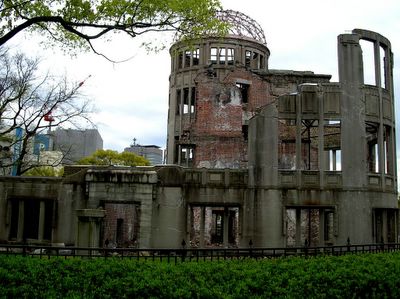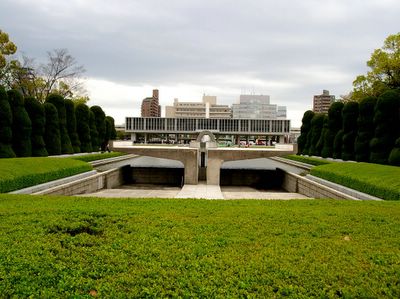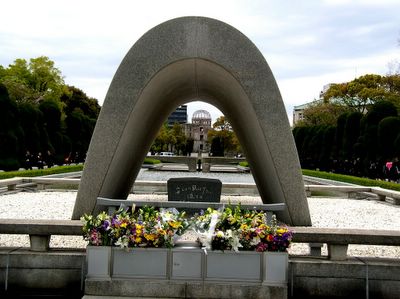World Heritage Site - Hiroshima Peace Memorial (Gembaku Dome [原爆ドーム])

Hiroshima Peace Memorial, called Gembaku Dome (原爆ドーム), the Atomic Bomb Dome, or the A-Bomb Dome by the Japanese is an UNESCO World Heritage Site located in Hiroshima, Japan.

The building was originally designed by Czech architect Jan Letzel. It was completed in April 1915, and the new building was named the Hiroshima Prefectural Commercial Exhibition (HMI).

It was formally opened to the public in August that year. In 1921 the name was changed to the Hiroshima Prefectural Products Exhibition Hall, and again in 1933 to the Hiroshima Prefectural Industrial Promotion Hall. The hall is used to promote Hiroshima’s regional products and cultural activity.

This is the Peace Flame at the center of the pond, its base representing outstretched hands.The flame was lit by clerics of many faiths, and will be extinguished when the last nuclear bomb is destroyed.
At 8.15 am 6 August 1945, an American B29 bomber dropped an atomic bomb, the first atomic bombing in human history.The bomb exploded almost directly above the building (the hypocenter with estimation that the shock wave from the bomb will create 35 tonnes per square meter pressure was 160 meters / 490 feet away), and it was the closest structure to withstand the explosion. It was one of the few buildings left standing within 2 kilometer (1.25 mile) radius from the explosion and has been preserved in the same state as immediately after the bombing.

The Memorial Cenotaph is the central monument to honor and console the souls of the victims of the A-bombing. It stands close to the exact center of Peace Memorial Park and was unveiled on August 6, 1952. The design evokes the primitive shelters provided to earthenware dolls buried in ancient burial mounds during the Kofun period (third to seventh century). The concrete structure was resurfaced with granite in March 1985.
It now serves as the reminder of nuclear devastation and as a symbol of hope for world peace and elimination of all nuclear weapons.

This is the Hiroshima National Peace Memorial Hall for the Atomic Bomb Victims
After the city was destroyed, it was said that nothing would grow there for decades. But when a tree nearby, began to show signs of life after the blast, it gave great hope and inspiration to the survivors.

This is the Children's Peace Monument, also known as the Tower of the Paper Cranes.

This monument was inspired by Sadako Sasaki, a vivacious young girl struck down by radiation aftereffects. Sadako who is 2 years old at the time of the bombing, was one of many children who developed leukemia about ten years later. On top of the concrete tower stands the bronze statue of a young girl holding over her head a huge paper crane symbolizing the hope of all children for a peaceful future.

Thousands of origami peace cranes brought to the park by schoolchildren from Japan and throughout the world every year.

The cranes remember the story of Sadako Sasaki, a childhood a-bomb survivor, who died of leukemia in 1955.While hospitalized, her closest friend reminded her of the Japanese legend that if she folded a thousand paper cranes, the gods might grant her wish to be well again. With hope and determination, Sadako began folding, but she did not survive long enough to finish 1,000 cranes.
Some of the places nearby that i missed are the Memorial for the Korean who died in the atomic bombing where many people were brought to Japan as forced laborers before and during World War II. A number of them were in Hiroshima at the time of the blast , A-bomb Memorial Mound and Peace Bell .
tags : Hiroshima Peace Memorial World Heritage Site Atomic Bomb Dome A-Bomb Dome Gembaku Dome 原爆ドーム



2 Comments:
It saddens my heart to know that the country I love was, and is so capable of such horrific destruction.
War of course tends to bring out the worst in humanity. Even when it brings out the best--as it was in the enormous scientific and technical effort involved in building the A-bomb in an extremely short time window (and considering 5+ years after 9/11 no one can take the reins to rebuild the WTC site it seems even more remarkable)--it's ultimately directed to very very bad things. I suppose Truman had an impossible no-win decision that even with the benefit of hindsight not everyone can agree was the best to be made. I doubt we ever will.
If the genie had been kept in the bottle I believe the US or the Soviets may have been more inclined to actually use atomic weaponry for warfare in the Cold War era.
Atomic energy is a great thing--far cleaner, more plentiful, and more capable of producing enormous amounts of energy than just about any other conventional form of fuel we have--but as a weapon it's just horrible. Unfortunately I don't believe Japan will be the last country to see atomic bombs exploded on their soil as an act of war--the US itself is probably due up for it, pretty soon, by fanatics. Whether total Armageddon ensues or not, the world will be even more different than it was after Hiroshima and Nagasaki. Perhaps then finally we'll have some appreciation for what the Japanese went through.
Post a Comment
<< Home